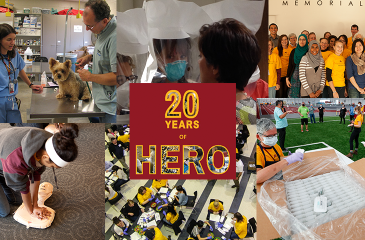Children’s cancer, brain tumors, pancreatic cancer and a range of neurological conditions comprise the diseases targeted by this year’s research projects selected by the Minnesota Partnership for Biotechnology and Medical Genomics. Five separate competitive grants will help partnering researchers advance early studies in medical science impacting conditions that have state-wide impact. Each project is the collaborative effort of a University of Minnesota and a Mayo Clinic investigator and take an approach that could not be pursued by either institution independently. This is the 17th anniversary for the state-funded awards, which this year provide medical researchers a total $4.6 million.
The projects and awardees for 2020 are:
“Development of a High Throughput Label-Free Platform Integrating Electronic Nanosensors and Holographic Imaging for Pancreatic Cancer Early Detection” Tianhong Cui, PhD, University of Minnesota and Martin Fernandez-Zapico, MD, Mayo Clinic
The American Cancer Society predicts more than a thousand new cases of pancreatic cancer in Minnesota this year and over 800 deaths from the disease. These two researchers are trying to change those figures by developing a means to detect pancreatic cancer much earlier, thus allowing physicians to start treatment much sooner. Cancer cells have different electrical and mechanical properties than healthy cells. The researchers hope to be able to detect electrical differences by using nanosensors and the physical or mechanical differences by using holographic images. The two combined technologies, if effective, could change diagnosis and drug screening for specific conditions.
“Mechanistic Dissection of the K27M Histone Mutation in Pediatric Gliomagenesis” Edward Hinchcliffe, PhD, Hormel Institute, University of Minnesota and Jann Sarkaria, MD, Mayo Clinic
Stated simply, this team is trying to learn enough about how errors in cell division cause brain cancers in children and why those tumors become aggressive. There is no cure or effective treatment for these children, but this research team will be using the new gene editing tool CRISPR in the laboratory to explore how imbalanced chromosome development – a major characteristic of pediatric brain tumors – can be detected, thus allowing for the creation of potential treatments.
“Peptide-Guided Delivery System to Improve Treatment for Pediatric Diffuse Intrinsic Pontine Gliomas” Hongbo Pang, PhD, University of Minnesota and David Daniels, MD, PhD, Mayo Clinic
One of the problems confronting physicians treating pediatric brain cancer, especially the tumors centered in the brainstem, is delivering drugs effectively into the solid tumor. This team, comprised of a basic scientist and a pediatric cancer surgeon, aims to change that by devising a new, more effective drug delivery system guided by a specialized form of peptides. A solution is urgently needed as post-diagnosis survival rates now stand at only 12 months.
“Magnetic Nanodevice Arrays for the Treatment of Neurological Diseases” Jian-Ping Wang, PhD, University of Minnesota and Kendall Lee, MD, PhD, Mayo Clinic
This team has a history of developing devices for deep-brain stimulation to treat neurological conditions. This plan is to develop a more advanced device, an implantable chip array - described as a flexible magnetic simulator - that could potentially help treat a range of conditions including Parkinson’s disease, essential tremor and dystonia, as well as Tourette’s syndrome, obsessive compulsive disorder and depression. The new array would avoid the current need to reprogram existing devices when cells migrate around them and obstruct signals.
“Overcoming Hormone Therapy Resistance in ER+HER2- Breast Cancer by Inhibition of Epoxyeicosatrienoic Acid Driven Signaling” David Potter, MD, PhD, University of Minnesota and Matthew Goetz, MD, Mayo Clinic
Every year 40,000 women with metastatic breast cancer in the U.S. die because their particular tumor type is resistant to hormone therapy. The latest drugs bring survival rates to just over three years. This research team has discovered the usefulness of the diabetes drug metformin in this therapy and have discovered it is 200 times more active than existing drugs in augmenting cancer therapy in these women. It’s the goal of this team to develop an even more effective analog of this compound and to test it in phase one clinical trials at the University and Mayo Clinic.



